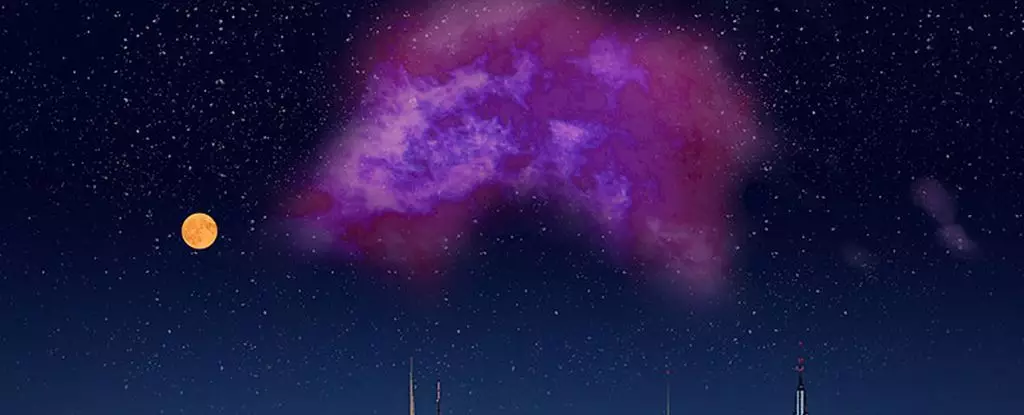In an astronomical breakthrough that evokes both awe and wonder, a colossal cloud of molecular hydrogen, cleverly named Eos after the Greek goddess of dawn, has finally stepped into the spotlight—an unobtrusive giant located merely 300 light-years from Earth. This remarkable discovery, positioned at the edge of the Local Bubble, offers fresh insights into the composition of our galaxy and the very nature of interstellar space. Eos epitomizes how much remains hidden from our view, providing a glimpse into the epoch when our universe began to form intricate structures from pure gaseous material.
Eos is a testament to the ingenuity of modern astronomy. Instead of using traditional methods to hunt for these elusive clouds, researchers opted for an innovative strategy that involved searching for the faint glow of far-ultraviolet light specifically emitted by molecular hydrogen. The findings were as illuminating as they were groundbreaking; this is the first time that scientists have directly detected interstellar molecular material using this technique. As astrophysicist Blakesley Burkhart from Rutgers University aptly states, “This cloud is literally glowing in the dark.”
The Invisible Fabric of Our Universe
When humans gaze at the star-studded heavens, we are often focused solely on the light from celestial bodies. However, the cosmos is anything but empty. The interstellar medium is a rich tapestry woven from tenuous molecular material drifting between stars, much like threads that form a grand fabric. It is easy to overlook these interstellar constituents, but they are crucial for forming stars and new worlds. Yet, identifying such clouds has proven to be a profoundly challenging endeavor.
Historically, astronomers have relied on various tracers like carbon monoxide to probe the interstellar medium. But what happens when clouds don’t host ample amounts of this common tracer? This was the dilemma tackled by Burkhart and her team as they ventured beyond convention. By utilizing observations from the STSat-1 ultraviolet space telescope based in South Korea, they shifted their focus back onto hydrogen—the predominant element in the universe. Hydrogen accounts for about 90 percent of the atoms and encompasses 73 percent of the universe’s mass, making it the logical primer for understanding the cosmos.
Measuring Eos: The Dimensions of Discovery
Eos is nothing short of awe-inspiring. With a diameter estimated to be about 80 to 85 light-years, this massive cloud contains roughly 2,000 solar masses of hydrogen. To put this into visual context, if Eos were visible to the naked eye, it would appear 40 times wider than a full Moon. But more than its sheer size, Eos serves as a cosmic laboratory for researchers who aim to decode the complexities of star formation and the life cycles of molecular clouds.
This newly discovered molecular structure is actively engaging with its stellar surroundings. Photodissociation—whereby the energy from nearby stars causes it to dissipate—has been observed, with a degradation rate of about 600 solar masses per million years. Astoundingly, scientists estimate that Eos could completely evaporate within a mere 5.7 million years—a blink of an eye in astronomical terms. Such rapid transformations prompt critical questions about the lifecycle of gaseous clouds and star systems.
A New Frontier in Astronomical Research
What enhances the excitement surrounding the discovery of Eos is its implications for future astronomical investigations. The success of utilizing far-ultraviolet emission unveils a new pathway for identifying previously “hidden” clouds that pervade both our Milky Way galaxy and beyond. According to cosmologist Thavisha Dharmawardena, this technique has the potential to revolutionize our understanding of the interstellar medium, hinting at a plethora of invisible structures waiting to be explored.
Understanding how molecular clouds form, evolve, and dissipate is crucial for comprehending galactic evolution. Eos offers an unprecedented opportunity for astronomers to observe and analyze the origins of stars and planets in real-time. As Burkhart points out, exploring these molecular clouds allows scientists to piece together the intricate puzzle of our galaxy’s formation and ultimately track the evolution of the universe.
The Dawn of a New Era in Astronomy
In an age characterized by rapid technological advancements and monumental discoveries, the identification of Eos epitomizes the forward momentum of astronomical research. This once-invisible cloud now stands as a marker of progress, igniting curiosity and inquiry among the scientific community. As we celebrate this breakthrough, we are reminded that the universe still holds many secrets, and the unveiling of Eos opens a door to those mysteries.
As researchers take the necessary steps to pave the way for future studies, Eos will undoubtedly become a focal point for understanding the nebulous nature of the cosmos. Our explorations are just beginning, and with each new discovery, we find ourselves not only learning more about our universe but also confronting the endless wonder it inspires.

